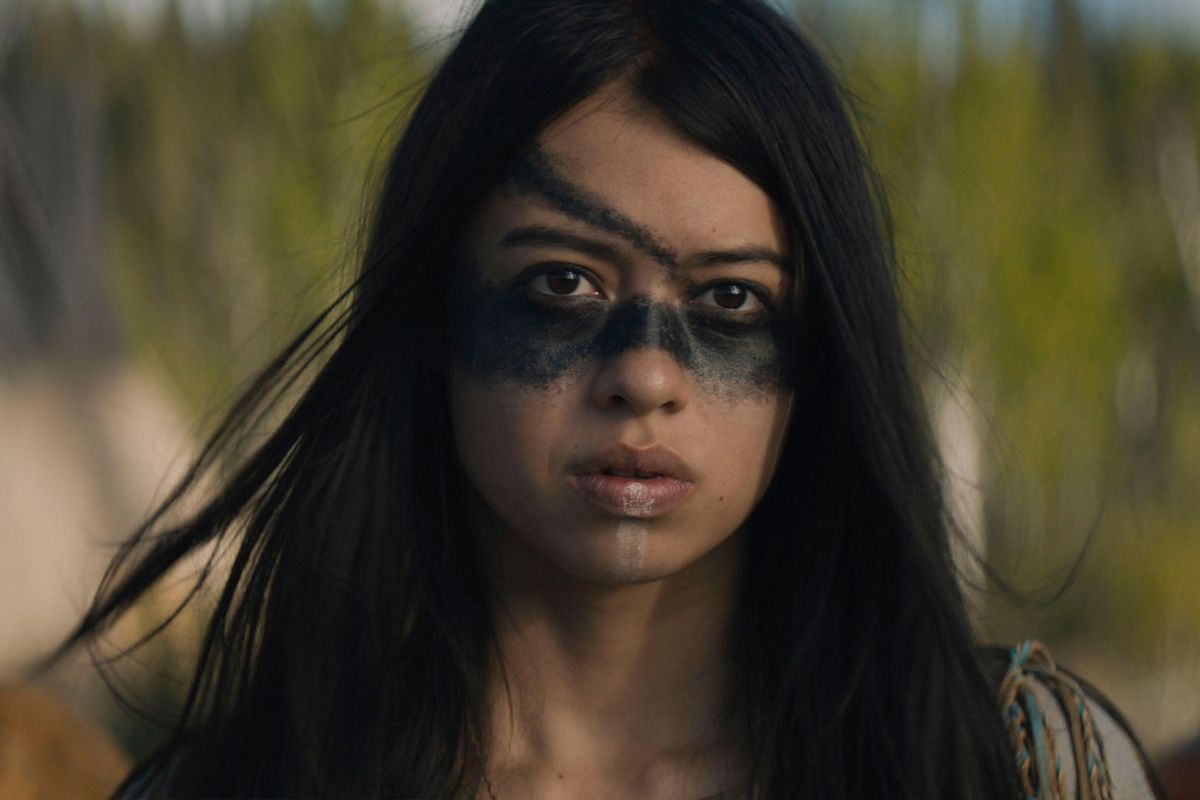"Prey" yields a slew of reasons to sing its praises. But for a certain viewer, what makes the latest round in the "Predator" franchise stands head and shoulders above its four predecessors is Naru, Amber Midthunder's aspiring Comanche hunter.
Tradition designates women as caregivers in charge of domestic tasks, but Naru doesn't subscribe to that role. She's more at home tracking game with her loyal dog Sarii at her side.
That's how she crosses paths with an enormous bipedal alien that sees Earth as its own game preserve and humans as the ultimate prize. Naru's peers don't believe her when she tries to warn them that a new danger is nearby; they think the tracks she's found belong to a bear. Instead of leaving that problem to them, however, she heads out to confront it . . . solo.
A couple of years ago I spelled out my frustration at pop culture's persistent rehashing of the white warrior woman archetype, lamenting the dearth of such leading roles for women of color.
"Prey" delivers a potent response through Midthunder's Naru, a warrior who is not a divine weapon or designated to fulfill some distant purpose, but simply someone who wants to live her life as she sees fit.
Naru knows things, like how to gather and use medicinal plants, and notices things men don't, like the way the otherworldly butcher hunting the rest of her party uses his tools and how they work.
Midthunder's Naru is not a divine weapon or ...designated to fulfill some distant purpose, but simply someone who wanted to live her life as she sees fit.
No one except for her brother Taabe (Dakota Beavers) is interested in helping Naru to complete the rite of passage known as Kühtaamia, requiring warriors to successfully track and confront prey that's also hunting them. So she trains hard, innovates improvements to her weapons to make up for what she may lack in brute strength, and learns how to move through her environment with caution and courage.
Naru brings home the head of the same type of alien that nearly ended Arnold Schwarzenegger's special forces commander in the original 1987 "Predator" movie.
And that act also proves these lethal aliens are equal opportunity foes: neither his soldier, Dutch, nor Naru, are strong enough to physically overpower a Predator. They can only defeat it by being intelligent. That's why women have survived Predator encounters before, as shown in 2004's "Alien vs. Predator," an offshoot of the franchise where Sanaa Lathan's artic guide outlasted her alien fighting partner, and in 2010's "Predators," where Alice Braga's Isabelle lives through the hunt to survive another.
However, and no shade to those ladies, Naru's triumph is hers alone, earned by employing ingenuity and bravery that isn't explained by any mystical boon or prophecy.
 Ania (Cody Big Tobacco), Itsee (Harlan Kywayhat), Wasape (Stormee Kipp), Taabe (Dakota Beavers) and Naru (Amber Midthunder) in "Prey" (Photo courtesy of 20th Century Studios)
Ania (Cody Big Tobacco), Itsee (Harlan Kywayhat), Wasape (Stormee Kipp), Taabe (Dakota Beavers) and Naru (Amber Midthunder) in "Prey" (Photo courtesy of 20th Century Studios)
"Prey" is an alien encounter set in the Northern Great Plains, circa 1719, where Naru, Tanabe, and their Comanche Nation community come under threat by a hunter from outer space, as well as colonizing Frenchmen who are equally as alien and vastly more thoughtless about their violence. The white men kill and maim anything they come across; at least Naru, like the Predator, has a code and standards.
The movie is also a work of meticulous creative precision top to bottom, starting with director Dan Trachtenberg's decision to shoot the film in versions featuring the English language and the Comanche language.
Along with producer Jhane Myers' dedicated insistence on presenting the details of 18th-century life in the Comanche Nation as accurately as possible and the work of a primarily Native cast, the director, producers, and cast create a multi-sensory experience out of what could have been a simplistic action slaughter.
But in Naru, we have an alternative to the European-history inspired model of the warrior woman who doesn't have to explain why she yearns to run with other hunters. Everyone in her community seems passionate about it, and she excels at it. What they don't see is that she has the guts to look death in the face and say, "This is as far as you go."
To declare Naru to be the start of a trend of non-white women being featured in parts to rival "Xena: Warrior Princess," "Hanna," or "Buffy the Vampire Slayer" would be wildly optimistic. Fantasy producers are casting more inclusively these days, evidenced by the "Game of Thrones" prequel "House of the Dragon" and Prime Video's "The Lord of the Rings: The Ring of Power."
"House of the Dragon" prominently features a powerful clan of Black royals close to the heart of the action, while "The Ring of Power" populates Middle Earth with humans, dwarves, hobbits, and elves of every complexion. But the women riding the dragons are still the palest ones, and in this TV adaptation of J.R.R. Tolkien the golden-haired Galadriel commands the central focus.
This TV season witnessed the debut and demise of Ava DuVernay's adaptation of "Naomi," a Black teenage superhero from the DC universe, along with the cancellation of The CW's "Charmed" remake, where Latinx women were The Charmed Ones.
Want a daily wrap-up of all the news and commentary Salon has to offer? Subscribe to our morning newsletter, Crash Course.
Those shows, and others like them, wrought small cracks in the unspoken standard implying that these mantles can only be borne by white women, in the same way that high fantasy characters have long been coded white. And now our ability to watch them has ended.
We may yet see an HBO adaptation of Nnedi Okorafor's 2010 fantasy novel "Who Fears Death," which Tessa Thompson is executive producing alongside George R.R. Martin.
And, as if we could forget, "Black Panther: Wakanda Forever" arrives in a couple of months and charges King T'Challa's mother, sister, lover, and trusted general – all women – with defending their nation. Wakanda is mythical, but it lacks the problematic history rewrite required to make the forthcoming Viola Davis-starring "The Woman King" and its lionizing of a kingdom built on the slave trade palatable. Plainly this genre has quite a distance to travel to achieve representational parity that doesn't come at the cost of justice.
"Prey" and Naru exist free of such concerns owing to the care taken to make her adventure breathe . . . and bleed. Midthunder's athletic portrayal of a woman coming of age on her own terms should, by rights, open more creators' minds to the possibility of seeing more characters fit to follow her path.
Naru achieved greatness where previous heroes in her place merely survived. She also shows us that when it comes to looking beyond the standard picture of what a hero looks like, movie audiences are ready for creators to go much further.
"Prey" is streaming on Hulu.



Shares